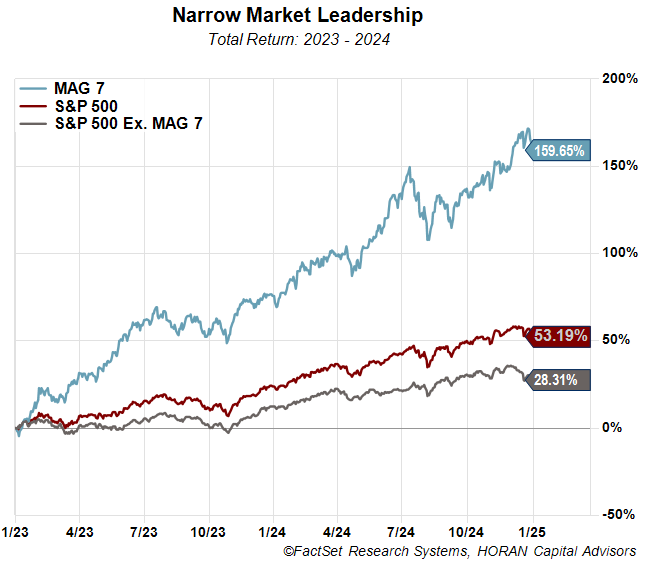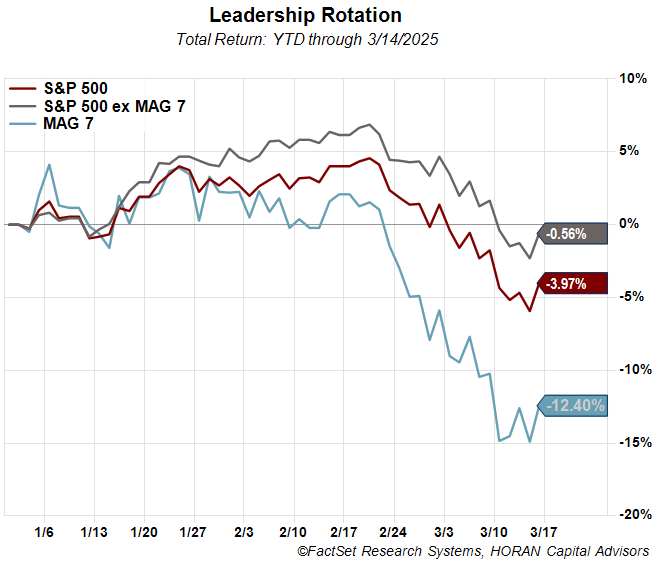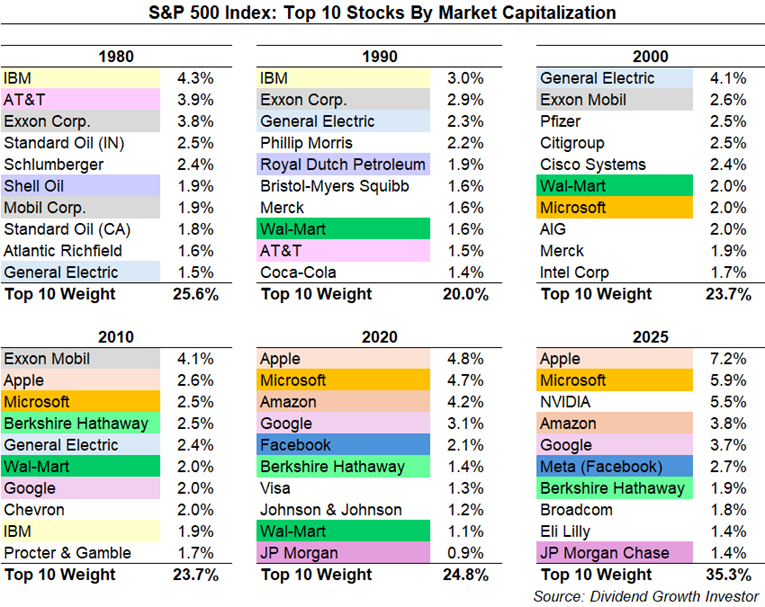Much has been written about the Magnificent 7 stocks (Apple, Microsoft, Nvidia, Meta, Alphabet (Google), Amazon, and Tesla) and the fact stocks of these companies have significantly outperformed the other 493 companies making up the S&P 500 over the last two years. The below chart shows the magnitude of this outperformance. In the two-year period of 2023 and 2024 the Magnificent 7 stocks are up 159% while the remaining 493 stocks in the S&P 500 Index are up just 28%. As noted in HORAN's Winter 2024 Investor Letter, the Mag 7 stocks accounted for over 50% of the S&P 500 Index return in 2024.

There are risks associated with investing in a portfolio with a small number of companies, i.e., a concentrated portfolio. As noted in a recent article by Russell Investments,
"The recent dominance of the Magnificent 7 technology names may help fuel the common belief that a single stock portfolio is the best way to deliver extraordinary returns. But looking back over a longer-term horizon, a concentrated stock portfolio has often led to greater volatility and potential losses. While holding a big chunk of a portfolio in one specific name can offer the potential for outsized gains, it can also expose investors to significant risks."
The equity market volatility that has ushered in 2025 is evidence of the risk associated with a concentrated portfolio. For many investors, simply investing in an index like the S&P 500 Index has possibly, and unwittingly, exposed investors to this concentration issue. As more money is allocated to the capitalization weighted S&P 500 Index, more investment dollars go towards purchasing these larger companies. With the recent Index volatility, and especially with the MAG 7 stocks, investors would have benefited by owning more of the other 493 stocks as seen in the below chart.

The factor that tends to influence stock returns and create a focus on a narrow group of stocks is associated with the theme that is driving economic activity. A theme impacting the economy this decade that is a significant driver of returns is the growth in the Artificial Intelligence area. Other themes have contributed to returns in earlier decades. As these themes change over time, the largest companies in the Index change. As seen below, the 10 largest companies in the S&P 500 Index are not the same for each decade. If a company in the below table is not shaded, it means the company only appeared as the largest company in one decade. Also, in years like 2010 only two companies remained a top 10 largest versus the start of the decade of 2000 and they were Microsoft and Wal-Mart. In short, what is a Top 10 company in one decade can fall out of favor and decline or other companies can assume a leadership position and exhibit faster growth based on favorable thematic factors or a combination of both.

The last column in the above table represents the largest ten companies in 2025. Notable is the fact these ten companies account for over 35% of the weighting in S&P 500 Index and the composition of the Top10 is already changing compared to the start of the decade in 2020. In short, the Index has become very concentrated and exposes investors to this concentration risk.
Investors can minimize concentration risk by constructing a diversified portfolio such as including an allocation to international stocks or alternative investments. For investors with a concentration in a single stock, strategies are available to diversify the position in a tax efficient manner as noted in the white paper, Unlocking Concentration Risk.
HORAN Wealth is the marketing name of HORAN Securities, Inc. ("HSI") and HORAN Capital Advisors, LLC ("HCA"). Securities Offered Through M Holdings Securities, Inc., a Registered Broker/Dealer, Member FINRA/SIPC. HORAN Wealth Management ("HWM") is the investment advisory firm. HCA is an affiliated investment advisory firm.
The information herein has been obtained from sources believed to be reliable but we cannot assure its accuracy or completeness. Neither the information nor any opinion expressed constitutes a solicitation for the purchase or sale of any security. Any reference to past performance is not to be implied or construed as a guarantee of future results. Market conditions can vary widely over time and there is always the potential of losing money when investing in securities. HORAN Wealth and its affiliates do not provide tax, legal, or accounting advice. This material has been prepared for informational purposes only and is not intended to provide and should not be relied on for tax, legal, or accounting advice. You should consult your own tax, legal, and accounting advisors before engaging in any transaction.

